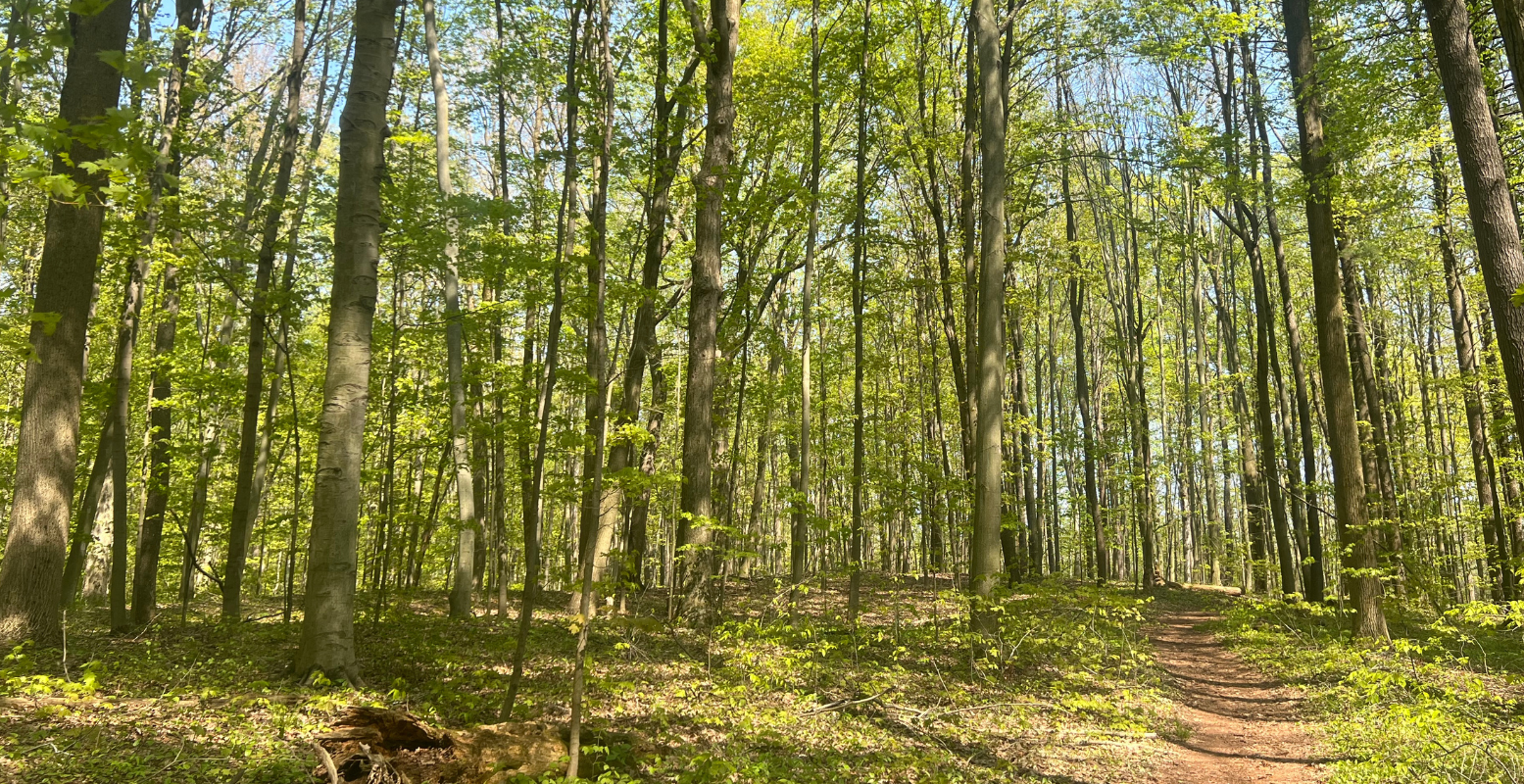Introduction
Norfolk County supports between 25% and 30% forest cover, among the highest percentage in southwestern Ontario, just behind Bruce County (~40%) and Grey County (~50%). This large concentration of habitat supports a vast diversity of wildlife species – including many threatened species and those with southern affinities – sometimes termed “Carolinian” species. The ecological importance of Norfolk’s forests has gained it recognition as conservation priority place – the only such designation in Ontario.
Long Point Basin’s forests are managed by a wide variety of entities. These include a vast network of conservation lands owned by Long Point Basin Land Trust and the Nature Conservancy of Canada, public forestry parcels owned by Norfolk County and Long Point Region Conservation Authority, and other forested parcels on hundreds of private properties. Forest conservation and stewardship efforts conducted by Long Point Basin alongside conservation partners are discussed in a local news feature by Sue Graci, published in the Port Dover Maple Leaf.

Forest types and composition
There are a wide variety of forest types within the Long Point Region. In moist areas, mesophytes, such as Sugar Maple (Acer saccharum), American Beech (Fagus grandifolia), Red Maple (Acer rubrum), Yellow Birch (Betula lutea), White Ash (Fraxinus americana), Basswood (Tilia americana), Tuliptree (Liriodendron tulipifera), Bitternut Hickory (Carya cordiformis), Shagbark Hickory Carya ovata), oaks (Quercus sp.), Sassafras (Sassafras albidum), Butternut (Juglans cinerea) and Black Cherry (Prunus serotina), sometimes Eastern Hemlock (Tsuga canadensis) if the microclimate is cool. Understories of mesophytic forests often have a very diverse set of shrubs, wildflowers and ferns. On slightly drier or sandier sites, the forest vegetation towards a more Oak-dominated community – with Red Oak (Quercus rubra), White Oak (Quercus alba), Black Oak (Quercus velutina), Chinquapin Oak (Quercus muehlenbergii), Red Maple, Black Cherry, often White Pine (Pinus strobus), and historically, the American Chestnut (Castanea dentata) tree. Examples are found in Jackson-Gunn Old-Growth forest (a rare, unlogged forests with 300+ year old trees), Backus Woods, the Rowanwood, Springwater Forest, and St. Williams Conservation Reserve.
On the driest sites, the forest transforms into a oak woodland-savanna ecosystems with a more open canopy. These vegetation communities, although only comprising a small portion of the total forest cover, host large concentrations of rare species! Dominant trees are Black Oak, White Oak, Red Oak, Chinquapin Oak, Black Cherry, White Pine and Red Pine (Pinus resinosa), sometimes with Red Maple. The largest expanses of oak woodland-savanna are found within Turkey Point, and adjacent areas of St. Williams Conservation Reserve.
Many forested natural areas in the Long Point Basin are also wetlands. Swamps are characterized by a vastly different vegetation community than uplands. White / American Elm (Ulmus americana), Green Ash (Fraxinus pennsylvanica), Black Ash (Fraxinus nigra), Pumpkin Ash (Fraxinus profunda), Cottonwood (Populus deltoides), and Silver Maple (Acer saccharinum). However, due to the impacts of Dutch Elm Disease (Ophiostoma novo-ulmi), and Emerald Ash Borer Beetle (Agrilus planipennis) – Silver Maple is by far the most common canopy tree of Long Point’s swamps today. In more sandy and acidic areas, Black Tupelo / Gum (Nyssa sylvatica) and Swamp White Oak (Quercus bicolor), can also have a major presence. Deciduous swamps widespread Long Point Basin, including Backus Woods, and the Rowanwood.
Among the most species-rich (biodiverse) forest types are riparian forests – forests growing in the vicinity of major watercourses, such as rivers – including Big Creek, Venison Creek, Deidrick’s Creek, Big Otter Creek, and Catfish Creek. Riparian tree species include Black Maple (Acer nigrum), Hackberry (Celtis occidentalis), Black Walnut (Juglans nigra), Burr Oak (Quercus macrocarpa), White Elm, Red Elm (Ulmus rubra), Red Oak, Basswood, White Ash, Green Ash, and hickories. In the Catfish Creek watershed, the rare Blue Ash (Fraxinus quadrangulata) is also found. Underneath this canopy is a vast diversity of shrubs and wildflowers. In narrow bands directly adjacent to the water grows the riverine forest type, – dominated by Sycamore (Platanus occidentalis), Black Willow (Salix nigra), White Elm, Silver Maple, and Cottonwood, within areas that experience regular seasonal flooding. Healthy examples of riparian forests are found within protected Nature Conservancy of Canada lands along the Big Creek corridor, Backus Woods, and Yarmouth Natural Heritage Area along Catfish Creek.
Fun facts
- The Long Point Region is home to most of Canada’s Cucumber Trees (Magnolia accuminata); Canada’s only native Magnolia. They grow in mesophytic forests alongside Sugar Maple, White Ash, and Tuliptree.
- In total, there are 49 canopy tree species in the Long Point Basin, and dozens of understory species.
- Norfolk County is a leader in reforestation, with thousands of hectares of marginal lands reforested in the last century!
—
Written by Matthew Palarchio, HBSc in Environmental Sciences, Western University
Photos by Matthew Palarchio

